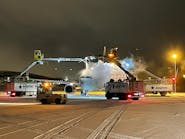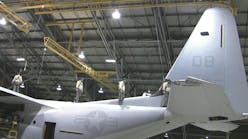The MSA Safety WinGrip System is a vacuum anchor fall protection solution for aircraft maintenance and manufacturing. Wearing full body harnesses, workers attach to the system via work positioning ropes.
Specifically, the system is designed for fall “restraint” (fall prevention) instead of fall “arrest” (stopping a fall once it starts). In other words, the system helps eliminate falls as well as the risk of working without a safe fall clearance, and the risk of sustaining injuries when falling.
Because the WinGrip Vacuum Anchor is connected to the aircraft, it’s mobile. It can be fixed to wings, the fuselage or stabilizers, eliminating the need for an overhead lifeline, and can span the length of any aircraft wing.
Alfonso Fernandez, MSA Safety Marketing Manager for Fall Protection, added, “Workers can find the perfect spot for the job, with no interferences with other structures or cranes.”
The WinGrip Vacuum Anchor was first introduced about 20 years ago and developed as a solution for airlines concerned about fall risks when employees worked on top of aircraft. Today, Fernandez said the system is used by the major aircraft manufacturers in the United States, Europe, Canada and Latin America and major airlines and MROs around the world.
The anchor is energy-absorbing. The system has been tested and rated for fall arrest, limiting load transfers to the aircraft structure. In the event of a fall, if the system didn’t include the energy-absorbing anchor, the load would be transferred to the aircraft structure, causing damage to the aircraft.
Interviewed by Aircraft Maintenance Technology, Fernandez shared more details about the system.
What are the different versions?
Fernandez: Different configurations are available depending on the specific tasks and needs. The All-in-One (AIO) and the Single/Multi-Anchor Device both are suitable for line maintenance and inspection, checks A and B, like logo light, quick wing inspection, pylon access, dry bay or wing cleanings. The Multi-User System is fit for base maintenance and production, checks C and D, like overall maintenance and fuselage.
- AIO (All-in-One): It’s a self-contained, compact lightweight vacuum anchor pad that is designed for a single user to access aircraft wings, fuselage or stabilizers. Often used in line maintenance, a single user has 360-degree movement around a single anchor point and pad provides a 3-meter radius working area. The working rope to attach to the back of harness comes with the WinGrip and it is adjustable to allow the user to create a safe working position based on the area needed to work. An additional pad can be attached to create a larger working area and also allows the user to “step stone” along the work area with at least one unit always connected to the aircraft.
- Multiple User Lifeline System: It’s often used by original equipment managers (OEMs) and maintenance, repair and overhaul (MROs) doing heavy maintenance. Up to four users can use the system at a time without disconnecting the system. This system sets a working area for various areas by means of deploying a horizontal lifeline or guardrails.
Where can the system be used?
Fernandez: The WinGrip system can be used on wet and dry surfaces, inside hangars or on the apron. It can be used in temperatures ranging from -4°F to +131°F (-20°C to +55°C). It can also be used at high altitudes, for example, it’s used in hangars in Bogota, Colombia, that are at 9,800 feet (3,000 meters) above sea level. The WinGrip may be used at any angle between 0 and 90 degrees. It should not be used upside down, and the device should not be positioned where water could accumulate or when frost or freezing conditions could create a hazard.
How does it work?
Fernandez: The WinGrip Vacuum Anchor is powered by compressed air or nitrogen, portable or by an air supply depending on the configuration. The portable device clips onto the unit and provides six hours of use. With no electric components, the system is safe to use with open fuel tanks.
Basic set up of the system takes about 30 seconds to connect the air supply, power on the WinGrip, attach a work positioning rope to the energy absorber.
The system’s safety features include three gauges to show supply pressure, system vacuum and anchor point vacuum.
If the air supply is disrupted, a red warning indicator will appear, and an audible alarm will sound.
After vacuum generation has ceased and the alarm sounds, the vacuum pad will remain safe for a minimum of 20 minutes, provided that safety checks have been carried out.
Other thoughts?
Fernandez: The system helps to keep workers safe under a great variety of conditions. At MSA Safety, our mission is to help keep workers safe on the job. Our WinGrip system should be deployed with the right training. At MSA, we take a lot of time to train users, to give them the proper knowledge and understanding, and to help ensure the system is correctly serviced.




